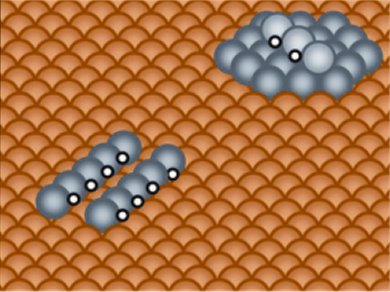The atomic-scale structure, composition, and catalytic properties of Pd–Au and Pd–Cu bimetallic alloys have been investigated by using scanning tunneling microscopy (STM).
Charles Sykes and co-workers, Tufts University, Massachusetts, USA, have shown that single, isolated Pd atoms in an otherwise inert Cu matrix are responsible for the dissociation of hydrogen and subsequent spillover of H onto Cu sites at 420 K. In contrast, for the Pd–Au sample, no H spillover occurs on the Au sites under the same conditions; significant H uptake only occurs when larger ensembles of Pd are present.
Depending on the surface temperature during the alloying procedure, a range of metastable states of Pd can be formed including Pd atoms on the surface and subsurface layers, and Pd islands on Au(111). Exposure to H2 is found to induce ejection of Pd atoms from the surface and from the Pd islands to form novel striped structures in which PdH species aggregate on top of the Au surface and Pd islands in regularly-spaced rows.

- An Atomic-Scale View of Palladium Alloys and their Ability to Dissociate Molecular Hydrogen
A. E. Baber, H. L. Tierney, T. J. Lawton, E. C. H. Sykes,
ChemCatChem 2010, 2.
DOI: 10.1002/cctc.201000309




